Westminster Abbey: England's "Parish Church"
by Helen Gazeley
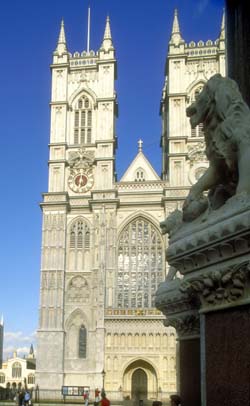 "The parish
church of the English-speaking peoples" seems an unlikely
description of Westminster Abbey, which is, after all, in a major
city, surrounded by government buildings. But it is packed with
the graves of world-famous people and has been the setting of
ceremonies watched internationally, from Queen Elizabeth's
coronation (1953) to the funeral of Diana, Princess of Wales
(1997), so perhaps one of the deans of the Abbey was right when
he said, "It belongs to all." "The parish
church of the English-speaking peoples" seems an unlikely
description of Westminster Abbey, which is, after all, in a major
city, surrounded by government buildings. But it is packed with
the graves of world-famous people and has been the setting of
ceremonies watched internationally, from Queen Elizabeth's
coronation (1953) to the funeral of Diana, Princess of Wales
(1997), so perhaps one of the deans of the Abbey was right when
he said, "It belongs to all."
A church has stood on this site since at least the seventh
century. In the eleventh century, Edward the Confessor (reigned
1042-1066) built another: "the first in England erected in the
fashion which all now follow at great expense", as William of
Malmesbury said of its Norman architecture. Edward actually
wanted to see Rome, but unrest was rife in England and he thought
that, if he went, he wouldn't have a throne to come back to. So
Edward swapped his pledge to visit the Pope with a promise to
build a great church to honour St Peter.
It's fitting, then, that the Abbey itself became a place of
pilgrimage, containing not only many relics (lost after the
Reformation but described by a medieval visitor as one of the
sights of London), but also the bones of Edward the Confessor
himself. When Henry III (1216-1272) began the erection of the
current abbey in 1245, he did so to venerate these bones, and
built the splendid shrine to Edward still there today.
To this shrine Henry V made solemn progress in 1415, to give
thanks for victory against the French at Agincourt. Despite the
loudly cheering citizens, triumphal arches, and fountains flowing
with wine, not once during the five-hour procession across London
did Henry smile. All glory should go to God and St George, he
said, and no thanks given to him.
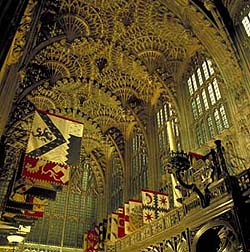 The Court settled around the Abbey, and royal
dwellings grew into the Palace of Westminster (mostly destroyed
by fire, 1834), the heart of royal and government administration.
By the fifteenth century (while the current nave was still being
worked on) the Abbey precincts were a warren of tiny streets,
full of alehouses and shops, all vying for business from the
Abbey and royal household. The Court settled around the Abbey, and royal
dwellings grew into the Palace of Westminster (mostly destroyed
by fire, 1834), the heart of royal and government administration.
By the fifteenth century (while the current nave was still being
worked on) the Abbey precincts were a warren of tiny streets,
full of alehouses and shops, all vying for business from the
Abbey and royal household.
And, most importantly, the Abbey provided Sanctuary -- safety for
the oppressed, the hunted, the accused. Once within its
precincts, no one, not even the king, had the right
to drag you out. Established in the time of King Sebert (seventh
century), this privilege protected many during civil war, or
while they gathered evidence in their defence. It didn't protect
everyone, however.
In 1378, two squires escaped from the Tower of London. They fled
from the City, not just into the precincts, but into the Abbey
itself, where mass was being said. The Constable of the Tower
would not turn back and, with his followers, burst into the
service. An outraged sacristan barred their way, only to be cut
down, and one of the squires was murdered on the very steps of
the altar. The outcry shook the country.
Although the right of Sanctuary disappeared in the 17th century,
and is now marked only in nearby road-names, the idea persisted,
and the streets in the area continued to be considered safe haven
for many decades. These streets, which the Great Fire of London
(1666) never reached, were cleared in 1851, after Parliament
decreed that new houses should be built in a style suitable to
the dignity of the Abbey.
To gain an idea of what the area was like before the renovations,
rather than coming to the Abbey across the traffic-rimmed
Parliament Square, approach from the south. If you've spent a
morning at Tate Britain, it's a pleasant stroll downriver,
through Smith Square and into Great College Street. Enter Dean's
Yard and the Abbey gardens, where the Benedictine monks grew
their food, and take in the Jewel Tower, a tiny fragment of the
old Palace of Westminster.
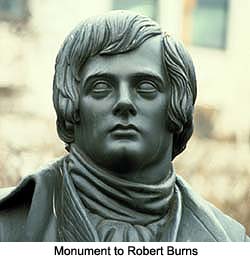 Then brace
yourself for the Abbey itself. Not only crowded with visitors,
this "parish church" is crammed with memorials -- a "strange
muddle and miscellany" wrote Virginia Woolf, "of objects both
hallowed and ridiculous." Then brace
yourself for the Abbey itself. Not only crowded with visitors,
this "parish church" is crammed with memorials -- a "strange
muddle and miscellany" wrote Virginia Woolf, "of objects both
hallowed and ridiculous."
At one time, a famous Briton might confidently expect to finish
up here. On boarding the ship San Carlo, Nelson
proclaimed, "Victory! Or Westminster Abbey!" (Actually, he was
buried in St Paul's, but the two churches have always been
rivals). But think of a famous Briton, and he or she is quite
probably commemorated, if not actually buried, here. There are
too many to mention them all: writers -- Dickens, Browning,
Tennyson; musicians -- Handel, Purcell, Vaughan Williams;
politicians -- Pitt, Gladstone, Chamberlain; scientists,
architects, explorers and reformers.
Some might be surprised to be here. Charles Darwin, despite his
atheism, joined the Hall of Fame alongside his hero, Sir John
Herschel, and Sir Isaac Newton. In the words of The Times
newspaper on Darwin's final resting-place, perhaps "The Abbey
needed it more than it needed the Abbey."
The absence of others appears a glaring omission. In 1880, George
Eliot, one of England's finest novelists, was still deemed at her
death a scarlet woman (she had eloped in 1854). Her friends
feared that controversy would overshadow her achievements and
dropped their demands for her burial in Poets' Corner.
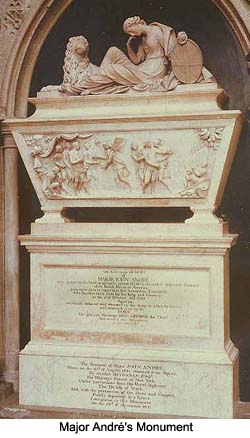 Scoundrels jostle with heroes. Look out for Tom
Thynne's memorial, on the wall near the organ. It shows the scene
of his murder in 1682. Thynne himself was so notorious a rake
that the Dean and Chapter refused to allow the normal eulogy on
his memorial and the space for it is still empty. Scoundrels jostle with heroes. Look out for Tom
Thynne's memorial, on the wall near the organ. It shows the scene
of his murder in 1682. Thynne himself was so notorious a rake
that the Dean and Chapter refused to allow the normal eulogy on
his memorial and the space for it is still empty.
And nearby, on the right-hand wall of the abbey, near the choir,
is Major André: hero or scoundrel, depending on your view
of the Atlantic. André was captured after collecting
intelligence supplied by Benedict Arnold. Sentenced to the
gallows, he asked to be shot, rather than hanged. The denial of
this request caused outrage in England and André's body
was brought back for a hero's burial.
On André's tomb is a likeness of George Washington. For
some time, whenever there was a row between Britain and America,
poor old Washington bore the brunt. His head was knocked off
twice almost as soon as the memorial was erected. The war of 1812
brought the need for another new head and the last
replacement was in the 1840s.
Above all, though, the Abbey is connected with royalty. More than
twenty monarchs are buried here, provoking the words from the
playwright, Francis Beaumont (1584-1616), who is also in Poets'
Corner, "Here's an acre sown indeed/With the richest, royalest
seed."
Queen Katherine of Valois, Henry V's bride, took longer to sow
than the rest. On her death in 1437, her coffin seems to have
remained in the Lady Chapel, open to view, until Henry VII
destroyed the Lady Chapel (in 1502) to make way for his own (it's
magnificent -- don't miss it). She was then moved next to her
husband, but still apparently open to the air. In 1669, Pepys
took his family to the Abbey. "Here we did see, by particular
favour, the body of Queen Katherine of ValoisÉAnd I did kiss her
mouth, reflecting upon it that I did kiss a Queen, and that this
was my birthday, 36 years old, that I did kiss a queen."
Katherine was finally interred in Henry V's chapel in 1878.

The royal tombs were matched in splendour by the funerals. Hugh
Walpole attended George II's. "The procession, through a line of
foot guards, every seventh man bearing a torch, the horse guards
lining the outside, their officers with drawn sabres and crape
sashes on horseback, the drums muffled, the fifes, bells tolling,
and minute guns -- all this was very solemn. But the charm was
the entrance of the Abbey, where we were received by the Dean and
Chapter in rich robes, the choir and alms-men bearing torches;
the whole Abbey so illuminated, that one saw it to greater
advantage than by day."
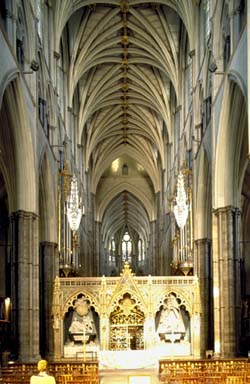 Henry V's coffin arrived after a two-month funeral
procession from France. On the carriage which bore it was a
greater than life-size image of the king, dressed in royal robes,
sceptre in one hand, a golden apple in the other. Surrounded by
torch-bearers and clergy dressed in white, the royal household
dressed in black, it must have been quite a sight when these and
three of Henry's favourite battle-horses advanced to the altar. Henry V's coffin arrived after a two-month funeral
procession from France. On the carriage which bore it was a
greater than life-size image of the king, dressed in royal robes,
sceptre in one hand, a golden apple in the other. Surrounded by
torch-bearers and clergy dressed in white, the royal household
dressed in black, it must have been quite a sight when these and
three of Henry's favourite battle-horses advanced to the altar.
Supremely, though, Westminster Abbey is a place of coronations.
Since William I in 1066, English monarchs have been crowned here.
The present Abbey was built to serve as a coronation church,
which is why there is a larger than normal space between the
Choir and the steps leading up to the High Altar. Most of the
ceremony occurs here, and you might like to linger and imagine
the scenes.
The diarist Celia Fiennes was present when Queen Anne (1702-1714)
was crowned. Dressed in crimson velvet with a six-yard long
train, the queen wore an under-robe "of gold tissue, very rich
embroidery of jewelsÉher petticoat the sameÉwith gold and silver
lace, between rows of diamonds." In her hair were diamonds which
"brilled and flamed." The altar "was finely decked with gold
tissue carpet and fine linen, on the top all the plate of the
Abbey set", while the officials were arrayed "in very rich copes
and mitres, black velvet embroidered with gold stars, or else
tissue of gold and silver."
Possibly no coronation can compare with George IV's, though. This
rather vain man demanded sumptuous proceedings with no thought
for expense. £24,000 was spent on the coronation robes
alone, when his successor, William IV (1830-37) spent only
£50,000 on the entire day. George wore a crimson train,
ornamented with golden stars, twenty-seven feet long. "Something
rustles, and a being buried in satin, feathers, and diamonds
rolls gracefully into his seat," said painter Benjamin Robert
Haydon (1786-1846).
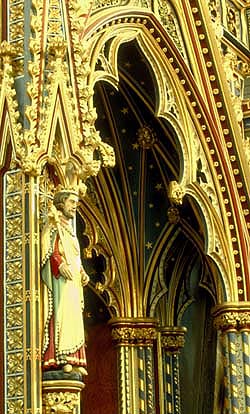 George had his comeuppance as he was almost overcome
with the heat of his robes. One royal page reported that the king
had required no fewer than nineteen handkerchiefs to mop his
royal brow while the peers paid him Homage. And "when the
Archbishop preached about burthens of Royalty, the King was seen
to wink at the Duke of York and point to his immense train." George had his comeuppance as he was almost overcome
with the heat of his robes. One royal page reported that the king
had required no fewer than nineteen handkerchiefs to mop his
royal brow while the peers paid him Homage. And "when the
Archbishop preached about burthens of Royalty, the King was seen
to wink at the Duke of York and point to his immense train."
Like George IV, congregations of the 18th and 19th centuries
showed little respect for the service. When the priest began his
sermon at George III's coronation, most of the congregation took
the opportunity "to eat their meal, when the general clattering
of knives, forks, plates, and glasses that ensued, produced a
most ridiculous effect, and a universal burst of laughter
followed."
But in other eras the ceremony engendered more respect and had,
perhaps, greater impact on those involved. In medieval times,
royalists believed that the anointing during the ceremony raised
the king to new heights: he became blessed of God. And while the
Reformation did away with any lingering idea that crowning was a
sacrament, coronation still had its effect. Queen Mary, the wife
of George V (1910-1936) "was almost shrinking as she walked up
the aisle," said the first Viscount Murray. "The contrast on her
'return' -- crowned -- was magnetic, as if she had undergone some
marvellous transformation. Instead of the shy creature for whom
one had felt pity, one saw her emerge from the ceremony with a
bearing and dignity, and a quiet confidence, signifying that she
really felt that she was Queen of this great Empire, and that she
derived strength and legitimate pride from the knowledge of
it."
And this, perhaps, is the secret of the Abbey. In the
ever-changing heart of London, it represents a continuity of
British history more than any other building. Standing on the
foundations of the old Norman abbey, it cradles and commemorates
heroes who have contributed to the world as well as Britain, and
returns every so often to the forefront of history as another
monarch is crowned before the altar.
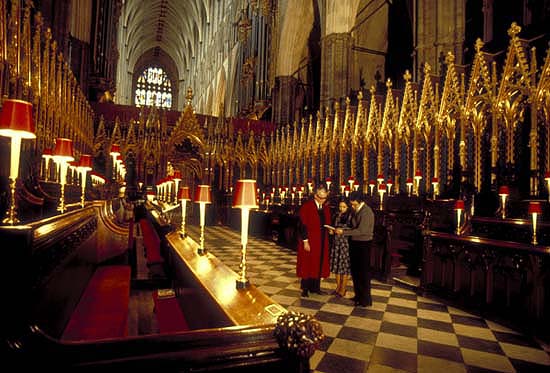
More Information:
We regret that we no longer have the resources to maintain up-to-date links and/or hours and pricing details for the various sites and attractions listed on this website. For more information about the location(s) listed above, please use your favorite search engine or visit Wikipedia.
Helen Gazeley is a freelance writer whose articles have appeared in the Daily Telegraph, Artists and Illustrators, Organic and Healthy Living and Kitchen Garden Magazine. She also writes a regular column for Organic Gardening. London and eating are two major enjoyments, so she knows a decent place to eat near any major attraction.
Article © 2006 Helen Gazeley.
Photos courtesy of Britainonview.com; André Memorial photo courtesy of Westminster Abbey.
|
